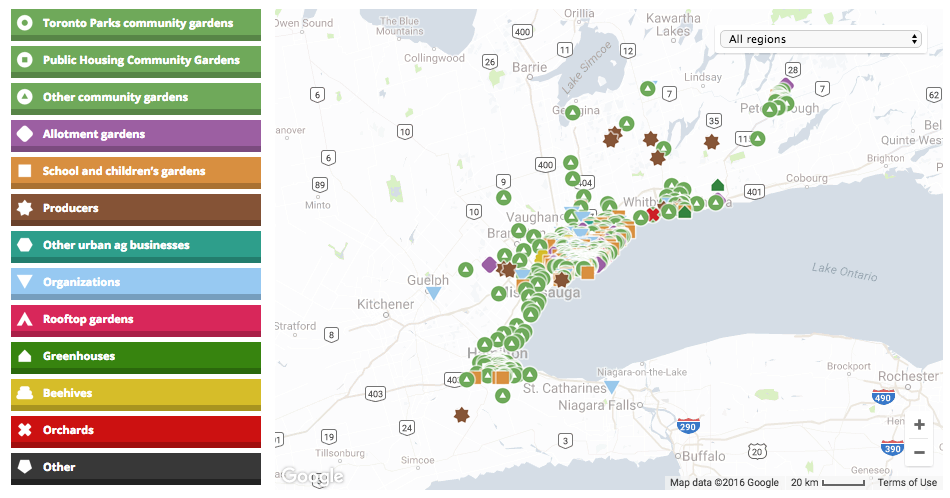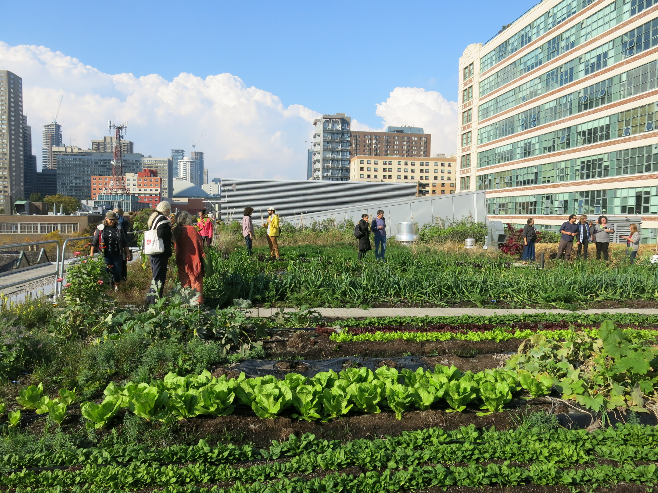 The roots of urban agriculture are growing far, wide and deep throughout the Golden Horseshoe, as the potential for growing food in cities is becoming realized. In fact, there are so many innovative urban growing projects, that it’s hard to keep track of them all.
The roots of urban agriculture are growing far, wide and deep throughout the Golden Horseshoe, as the potential for growing food in cities is becoming realized. In fact, there are so many innovative urban growing projects, that it’s hard to keep track of them all.
But Toronto Urban Growers (TUG), a diverse member-based network, has been working to do just that. Initially focused on the Toronto area, TUG has expanded efforts to capture urban agriculture projects across the entire Golden Horseshoe on a vibrant interactive map.
And as these urban ag projects are expanding in terms of scope and diversity across GGH regions, TUG has also been working to build its capacity to respond to the increased demand for information, resources and networking. Enter: TorontoUrbanGrowers.org/
TUG’s website is the new and improved online hub offering this valuable information and networking support. Developed by Montreal’s Bon Melon, based on the popular agriculturemontreal.com model, the newly-launched interactive map is a one-stop shop for information on urban ag projects across the Golden Horseshoe Region.
“The interest in urban agriculture is growing as quickly as the number of projects themselves,” says Rhonda Teitel-Payne, Co-coordinator with TUG. Urban agriculture can appear as community gardens in parks or rooftops, as programs run by community agencies or as co-ops, businesses and social enterprises. Whatever form they take, urban growers are looking for more information on municipal guidelines, how growing can heal individuals and communities, as well as increase green space and green infrastructure.
While urban ag is growing in popularity globally, TUG is working to tell the Golden Horseshoe’s unique story.
And so they have undergone the daunting task of collecting and mapping the many urban agriculture projects across the region. A number of organizations contributed data to the map, including the Golden Horseshoe Food and Farming Alliance; the GHFFA also contributed $10,000 to TUG to ensure that the map would use and include resources from outside the City of Toronto.
Various parties and groups will now be able to reap the benefits from this project. If a city councillor, for instance, wants to know what is going on in his or her neighbourhood, this map will give them an immediate snapshot. If a grower wants to look for potential partners or assistance, this tool will offer those connections with ease. The map has the capacity to show information on projects as well, so if you have a project of your own to share, you can register and load information about the project directly to the map (including photos and links). And the hope is that if regions see missing spots in their area, they will get in touch.

Ryerson Urban Farm, taken by June Komisar
However, it’s not just about finding other projects, but learning from them too.
In addition to the map, the online hub also offers a number of resources and educational tools for urban growers, businesses and organizations (on land, growing, fundraising, training and more).
“We are attempting to make things easier for people to find what is relevant for them,” shares Rhonda. “If you Google a term, you’ll come up with endless pages of information, so we’re trying to do some curating, and narrow the focus for people here.”
A “Key Documents & Policy” resource page offers policy information for each region, which TUG plans to continually build on. As policy decisions get made across these boundaries, compiled local resources and information will be a significant aid for those interested in developing green thumbs in the city.
While the tools are available to the public, TUG would also like people to contribute to and enhance the resources.
A public TUG Google Group already has about 600+ active users, where participants can post questions, provide answers, and share events.
Through this work, TUG is also making a conscious effort to bring more voices to the urban agriculture scene that often go unheard. Many newcomers to cities bring with them agrarian practices from other parts of the world. There is increasing interest in learning about Indigenous urban agriculture practices and culture that TUG hopes to highlight.
Although the website is an online resource, TUG doesn’t want that to pose any barriers for those that don’t have easy access to the web, and they are currently considering ways to make this information available to all. Website information can be printed and circulated in meetings, or used as resources by garden and project leaders.
As the Urban Agriculture site is a work-in-progress, TUG is looking for feedback: What are your ideas or needs? Does this website work well as a resource or does it needs more information? What works? What is missing?
Ready to dig in? Offer your thoughts and join the growing knowledge exchange here with Toronto Urban Growers!
Alongside the online hub, Toronto Urban Growers are on the ground working to: cultivate relationships, generate and share information, link growers to land, space and resources, help new leaders emerge, work with governments and other decision makers to develop and implement supportive policies that create space for innovation and development, promote the benefits of urban-grown food, and develop strategies to expand food production within the city.
